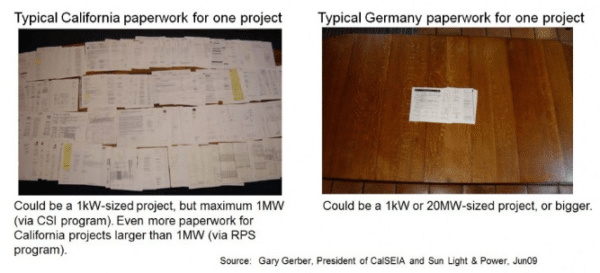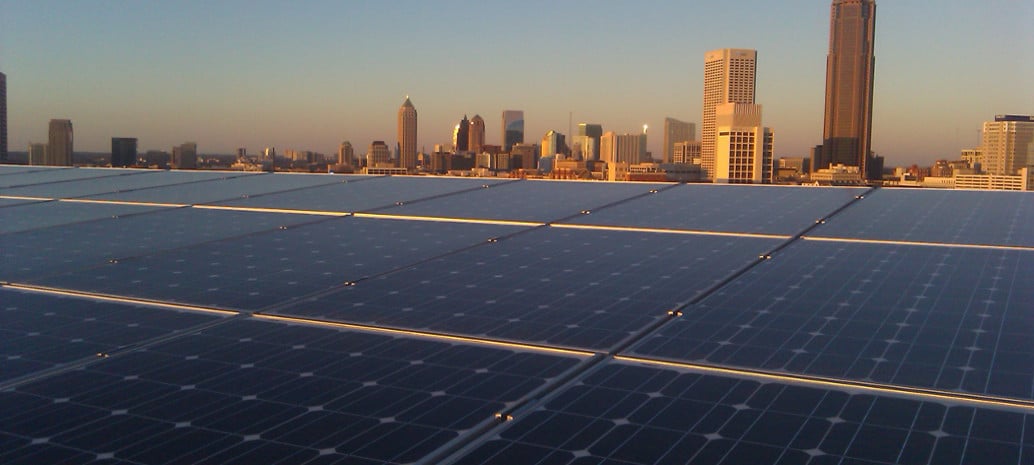By Dr. Frank Wasko, Program Director, Clean Coalition
 When Indra Ghosh applied for a permit from the City of San Jose to install 12 kW of solar on his home, a representative from his utility, Pacific Gas & Electric (PG&E), asked why he needed such a large solar system. Indra explained that his family was about to buy two electric vehicles. PG&E approved the installation, but they had to ask the question, because if a number of homes on a block were outfitted with large solar systems, the utility might need to replace pole-top transformers that each feed handfuls of homes with modern ones that handle bidirectional power flows.
When Indra Ghosh applied for a permit from the City of San Jose to install 12 kW of solar on his home, a representative from his utility, Pacific Gas & Electric (PG&E), asked why he needed such a large solar system. Indra explained that his family was about to buy two electric vehicles. PG&E approved the installation, but they had to ask the question, because if a number of homes on a block were outfitted with large solar systems, the utility might need to replace pole-top transformers that each feed handfuls of homes with modern ones that handle bidirectional power flows.
These are the kinds of conversations that happen as utilities work to integrate clean local energy projects while ensuring safe, reliable, and cost-effective grid operations. Any project that connects to the electricity grid — whether a residential solar, commercial-scale solar, or other advanced energy installation — goes through a permitting process to gain permission to interconnect with the electric grid. The approval process for commercial-scale solar, which has developed and evolved over decades, is in dire need of streamlining.
The state of California has already streamlined the residential solar process. Concerned about the inconsistent patchwork of municipal permitting requirements and fees, in 2015 the State passed the Expedited Solar Permitting Act (AB 2188), which requires California cities and counties to accelerate the permitting process for small residential rooftop solar energy systems. Key elements required by the bill include:
- Providing a checklist of requirements for an applicant to be eligible for expedited review
- Allowing electronic submittal with electronic signatures
- Providing a single inspection performed in a timely manner
Commercial-scale solar and other advanced energy projects — such as Solar Emergency Microgrids and electric vehicle charging infrastructure — would benefit from similar legislation.
Streamlining utility interconnection processes
The Peninsula Advanced Energy Community (PAEC) Initiative, funded by the California Energy Commission (CEC) and led by the Clean Coalition, studied this issue and came up with a number of recommendations. PAEC is a groundbreaking initiative to streamline policies and showcase projects that facilitate local renewables and other advanced energy solutions in San Mateo County, California, and beyond.

A Solar Siting Survey conducted in the core PAEC region of Redwood City, Atherton, Menlo Park, and East Palo Alto identified over 65 MW of large commercial-scale solar potential on rooftops, parking lots, and parking structures
The PAEC Initiative was particularly interested in accelerating the approval process for projects such as large solar carport systems, electric vehicle charging stations, and energy storage systems.
The Initiative reviewed 209 wholesale distributed generation (WDG) projects moving through the PG&E Fast Track approval process between 2012 and 2016. The PAEC report Best Practices: Interconnection for Local, Commercial-Scale, Renewable Energy Projects found that out of these 209 projects, only 18 percent, all smaller than 1 MW, were approved. For those that gained approval, the process took between six months and 2.25 years. The other 82 percent of Fast Track applicants were either rejected or dropped out. In some cases this was due to difficulties in obtaining local permits to build or install the facilities.
While the interconnection process needs to be rigorous to safeguard the electric grid, at this point these advanced energy solutions have been proven to be safe, so their deployment should be expedited. The PAEC report recommends these streamlining measures:
- Transparent application and review processes
- Predictable and reasonable timelines
- Enhanced queue management
- Accessible and efficient dispute resolution procedures
- Clear cost certainty
This webinar highlights more details about the PAEC report findings.
In addition to the report, the PAEC Initiative worked with PG&E to design a Pilot for Testing Streamlined Interconnection Procedures.
Streamlining municipal permitting processes
Municipal building permit departments are also gatekeepers of the clean local energy future, so it is important for them to cut red tape from their processes as well. After studying innovative best practices and conducting gap analyses at the municipal building permit level, the PAEC Initiative developed recommendations that included:
- Developing a standardized list of required documents and over-the-counter and/or electronic approval processes
- Expediting permitting for solar carports and for associated energy storage facilities that make the solar energy available when it can provide the greatest value
- Waiving permitting and plan check fees (in full or part) for solar carports and energy storage systems
These recommendations leveraged AB 2188’s requirements for expediting residential solar permitting.
Borrowing model ordinances
Another measure that will speed up adoption of advanced energy solutions is for municipalities to share best-practice ordinances. Some municipalities have already taken the time to study which measures will have the most impact, develop ordinance language, and vet the text with a working group. Copying successful ordinances will save time for other municipalities, and adopting consistent ordinances across local municipalities significantly reduces complexity and associated costs for regional developers.
The PAEC Initiative researched best practices across the country to define and promote these four model municipal ordinances:
- Electric Vehicle (EV) Charging Station Ordinance for Cost-Share in Leased Buildings
- EV Fast Charger Ordinance for New Large Retail Buildings
- Ordinance for Solar Photovoltaic Carports on New Parking
- Ordinance for Renewable Space and Water Heating
PAEC benefit-cost analysis of top potential ordinances
| Model ordinance | Total annual energy savings | Annual profit/ cost savings ($/year) | Payback (years) | Annual GHG reduction (MT C02) |
| EV charging stations for existing multi-unit residential buildings (1 charger per bldg) |
630 gallons of gasoline | $1,028 | 2.5 | 5 |
| EV fast chargers for new retail buildings (1 charger per bldg) | 10,005 gallons of gasoline | $5,713 | 5.7 | 87 |
| Solar carports for new commercial buildings (30,000-sq-ft office bldg) | 143,052 kWh | $33,811 | 7.0 | 15 |
| Energy efficiency measurement and verification for new commercial buildings (5,000-sq-ft bldg) | 29,300 kWh (net energy savings based on therms & electricity) | $6,925 | 15.9 | 3 |
Source: PAEC Final Benefit-Cost Analysis Report of Model Ordinances, by DNV GL. Figures are per average site; size of buildings and parking lots based on California End Use Survey (CEUS) data for commercial buildings and Residential Appliance Saturation Survey (RASS) for residential buildings.
Municipalities can borrow the text from these model ordinances, insert their name, and submit the ordinance for approval to their city council or county board — and thus avoid reinventing the wheel, or creating different standards and requirements for each jurisdiction.
A small amount of effort yields big benefits
At a time when many municipalities are expected to do more work with smaller staffs, the PAEC report estimates that streamlining permitting will save about $2,000 of labor per advanced energy project. This includes municipal staff time and project developer time.

The report also estimates that implementing its recommendations to streamline permitting at both the utility and the municipal levels will reduce the cost of clean local energy projects by 20 percent. These reduced costs will create a positive feedback loop that accelerates adoption of clean energy solutions, as lower costs will make the technologies accessible in more cases. This will help municipalities meet their Climate Action Plan goals, as well as their states’ ambitious greenhouse gas emission reduction goals.
The rigor and complexity of utility and municipality permitting for clean energy projects has increased over the past few decades, for good reason. It was important to ensure that deployed technologies were safe and reliable. At this point, though, commercial-scale solar, electric vehicle charging infrastructure, and energy storage systems are proven technologies. We now have the opportunity to streamline significant levels of unnecessary bureaucracy that burden permitting processes. It’s time for Permitting 2.0 to speed deployment of technologies that will build the clean local energy future we need.
The views and opinions expressed in this article are the author’s own, and do not necessarily reflect those held by pv magazine.
This content is protected by copyright and may not be reused. If you want to cooperate with us and would like to reuse some of our content, please contact: editors@pv-magazine.com.








By submitting this form you agree to pv magazine using your data for the purposes of publishing your comment.
Your personal data will only be disclosed or otherwise transmitted to third parties for the purposes of spam filtering or if this is necessary for technical maintenance of the website. Any other transfer to third parties will not take place unless this is justified on the basis of applicable data protection regulations or if pv magazine is legally obliged to do so.
You may revoke this consent at any time with effect for the future, in which case your personal data will be deleted immediately. Otherwise, your data will be deleted if pv magazine has processed your request or the purpose of data storage is fulfilled.
Further information on data privacy can be found in our Data Protection Policy.